Pent-up demand has consumers now looking for more upscale and/or unique experiences when hosting events.
“COVID blew it up, eliminating events and making us rethink [this segment],” says Ed Doyle, president of RealFood Hospitality, Strategy and Design in Newton, Mass. “It also has created an accelerant, as changes in the event space have moved more rapidly.”
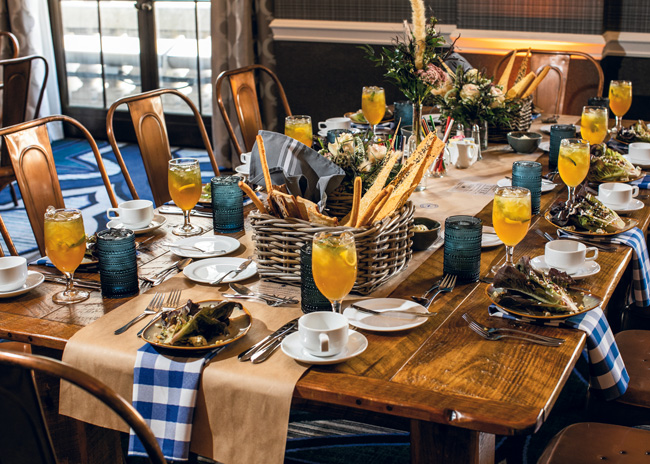 The Notary Hotel, Autograph Collection, PhiladelphiaLos Angeles-based market research firm IBISWorld’s May 2021 “Event Planners Industry Report” projected event industry revenues would total $3 billion in 2021, a 2.8% increase compared to the previous year. Despite this projected growth, though, the IBIS study predicted a 9.1% decline in event industry revenues between 2016 and 2021.
The Notary Hotel, Autograph Collection, PhiladelphiaLos Angeles-based market research firm IBISWorld’s May 2021 “Event Planners Industry Report” projected event industry revenues would total $3 billion in 2021, a 2.8% increase compared to the previous year. Despite this projected growth, though, the IBIS study predicted a 9.1% decline in event industry revenues between 2016 and 2021.
According to the report, corporate social events make up 48.6% of this segment’s revenue, followed by weddings at 27.5% and birthday parties at 16.6%.
With industry revenue expected to increase at an annualized rate of 2.8% between 2021 and 2026 to reach $3.5 billion, according to IBISWorld, there remains much potential for the events segment. “I do think the prevailing attitude and outlook is pretty optimistic and positive, even with the challenges this segment has been through,” says Tracy Lawler, president of JGL Consultants, located in Princeton, N.J. “It’s nice to see after the last two years.”
Segment Evolution
When looking at the events and catering segment’s evolution, it’s necessary to view it pre- and post-COVID-19. “Prior to the pandemic, things were moving in a very positive direction, with creativity and experiential events,” says Joseph Cozza, catering and event operations consultant at Cayuga Hospitality Consultants in Sarasota, Fla. “For decades, this segment had become more interesting and detailed, then COVID hit.”
The pandemic shifted most events into a virtual format almost overnight. “What has transpired as live events come back is we gravitated toward hybrid formats, with part live and part virtual,” Cozza says. “This has started becoming more sophisticated and engaging, especially for businesses, as technology catches up.”
With corporate events coming back slowly, it has become more important than ever for event and catering businesses to diversify clientele. “Organizations or venues that have the widest mix of events are the ones that bounce back the quickest,” says Lawler. “Because most of our clients tend to be museums, performing arts centers, and facilities and organizations that have real estate not being used in the evenings, diversifying provides more immunity against major disruptions.”
Hybrid events, as well as micro-sized weddings or those with a limited guest count, are now making way for more traditional gatherings, Lawler says. The pace of this transformation, though, depends on the region. “Due to those who put off events in 2020 and 2021, many venues are dealing with a shortage in available dates. As a result, more weddings and parties are being held on weekday evenings.”
It’s evident that the strong urge to meet in person remains, as people seek better, more engaging and more meaningful gatherings that provide a feeling of belonging and purpose. “Because expectations are higher, the industry has to up their game when it comes to the quality of food and beverages,” Cozza says.
This requires versatility and the ability to pivot as necessary. “More flexibility is needed for spaces to be accommodating,” says Will Meffert, director of sales at Atlanta-based restaurant operating group Concentric Restaurants. “The good news is business has been building in 2022 so far.”
To meet today’s expectations, it’s also necessary to rethink large-scale meal production. “Our industry has turned events and catering into a compromise, but you’d never go into a restaurant and expect the chef to put food in a hot box before it’s served,” Doyle notes. “It’s up to us as an industry to create a banquet experience on par with a la carte.”
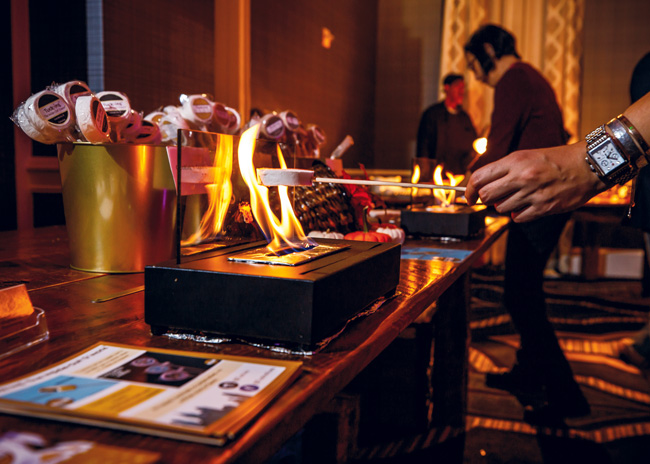 Action stations, such as this one at Pennsylvania’s Notary Hotel, create a unique and personalized experience for guests. Photo courtesy of Lafayette Hill Studios
Action stations, such as this one at Pennsylvania’s Notary Hotel, create a unique and personalized experience for guests. Photo courtesy of Lafayette Hill Studios
Improving Menus and Production
Along with labor shortages and supply chain issues, the event and catering segment is challenged with incorporating technology for hybrid events and improving menus and efficiencies in production.
This involves rethinking the production process, personalizing experiences and creating something unique. “Consumers have elevated the importance of getting value out of an experience,” Doyle says. “We need to think outside the box and find ways to deliver experiences more efficiently. How can we design kitchens and menus to do live plate-ups?”
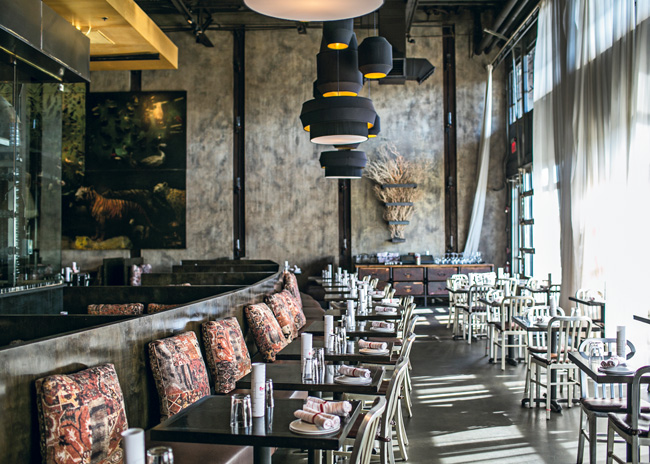 A modern, industrial design defines Two Urban Licks’ front-of-the-house space.And it all starts with the menu as consumer expectations remain consistent no matter the operator segment. “Improving variety and options is a challenge,” Cozza says. “Operations can be resistant, but customer expectations are there.”
A modern, industrial design defines Two Urban Licks’ front-of-the-house space.And it all starts with the menu as consumer expectations remain consistent no matter the operator segment. “Improving variety and options is a challenge,” Cozza says. “Operations can be resistant, but customer expectations are there.”
For catering and events operations, the labor issue extends to a shortage of sales staff necessary to procure clientele. “More time is needed for potential customers’ initial inquiries to be answered, when in the past the rule was to respond within 24 hours,” Lawler says. “Venues also are contending with dramatically dropping head counts and last-minute RSVPs, as people continue testing positive for COVID or shy away from gatherings due to a high rate of infection in their area.”
With some areas and operations still adhering to stricter pandemic protocols, event expectations also should be clearly communicated between the venue and client. “Some event spaces are still more hands-off with manned buffets or plated dinners, while others may have gone back to traditional buffets and family-style meals,” Meffert says. “Needs and requirements should be understood at the forefront.”
From a design perspective, it can be difficult to get a team on board in creating a kitchen concept that delivers a better banquet experience. “Too often, the industry is designing for the same catering or event space as 20 years ago,” Doyle says. “It’s a matter of skill in the back of house; volume shouldn’t be a factor. Leave more room for plating tables rather than hot boxes. And make these double-sided to get food out fast and hot. Spec combi ovens instead of convection ovens. When we designed a hotel this way, labor costs went down, as this enabled the operation to be
nimbler with staffing while delivering a better experience.”
Cook-chill can become another good production option, as it helps manage labor, ensure consistency in food quality and provide more menu options. “This involves combis and blast chillers, and may include retraining culinarians as well as incorporating new technology,” Doyle says. “Chefs tend to run with what they know, so if they can work with equipment partners on rethinking how to do banquets and are okay with being a little uncomfortable, it will create change.”
With challenges come opportunity, and this rings true in the events and catering segment. “There is still a level of uncertainty, so being safe is a priority,” Cozza says. “However, there are opportunities for operators who offer better quality events overall and delicious food with a touch of flair.”
This includes food and beverage presentation, which Cozza says should have a retail (rather than institutional) feel. “Rather than the traditional chafing dish, containers should include a mix of metal, ceramic and wood for visual enhancement,” he says.
In the front of the house, it’s about looking at new points of view on spaces and rejuvenating the decor, which requires a worthwhile investment, Meffert explains.
 A rethinking of spaces is happening at many events, such as this New York Historical Society event. Photo by Tony Powell
A rethinking of spaces is happening at many events, such as this New York Historical Society event. Photo by Tony Powell
Menu Flair
With today’s event menus, protein is less likely to dominate the plate. Plant-based options have become more commonplace. Farm-to-table and local ingredients prevail. And COVID-19-era pre-portioned appetizers remain at the forefront.
While still incorporating the customary chicken, steak and fish, menus continue to become more adventurous. “There’s an added flair to be different with things like Southwest-style hangar steak, smoked and spicier flavors, or including main dining menu items like chicken empanadas,” Meffert notes. “People are open to things that they don’t have at home or at traditional events.”
Concentric Restaurants’ Two Urban Licks restaurant cooks all catered meals to order, except its rotisserie chicken. “Everything on our catering menu is plated from the main kitchen, which can handle up to 70 guests for an event,” Meffert says. “For us, it’s all about timing and making sure the kitchen has the order ahead of time but is still maintaining the restaurant.”
In addition to cooking rotisserie chickens, Two Urban Licks handles prep ahead of time, including its brisket, which cooks overnight in a smoker that accommodates 15 slabs of meat at one time. “We add extra staff for catering and extra prep crew to come in ahead of time,” Meffert says. “Any event over 30 people warrants an extra person on the wood-fired grill or oven. We typically handle up to 800 guests on a Saturday, so adding 70 more during the week for an event is not a problem.”
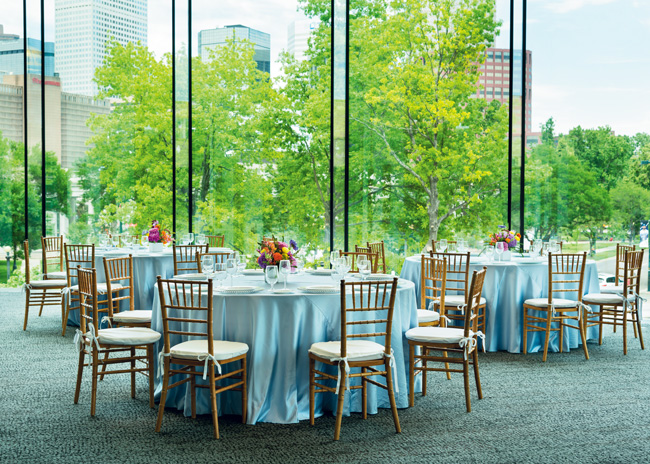 In event seating areas, the focus is on ambience and complementary colors.Two Urban Licks’ sister restaurant, Bully Boy, is directly next door and helps with prep when necessary.
In event seating areas, the focus is on ambience and complementary colors.Two Urban Licks’ sister restaurant, Bully Boy, is directly next door and helps with prep when necessary.
With event menus, host and guest preferences often must find a balance. “I’ve spoken with caterers who are receiving client inquiries about fully vegan events,” Lawler says. “On the flip side, some caterers are focused on minimizing their carbon footprint by pushing plant-forward options.”
“Menu trends in this segment include comfort, not junk, food like braised meat, rotisserie chicken, upscale pasta and risotto,” Cozza says. “We’re also seeing a mix of oils used, including vegetable, pumpkin and avocado.”
Buffets are back, with some taking on a traditional format, while others feature staff serving the food as guests make their way down the line. Some buffets even include only plated foods and/or action stations.
It’s also important not to lose sight of the beverage side, which offers many opportunities to differentiate. “How can we create environments for craft beverages, whether beer or cocktails, and create a barista experience with these items?” Doyle says. “Events can lean more toward batch cocktails but use craft and quality experiences and put these on draft to keep long lines at a minimum yet ensure consistency.”
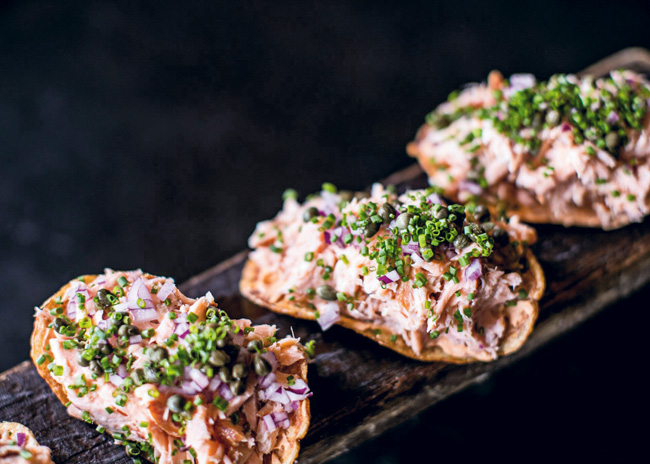 Event menus are becoming more creative, for example Two Urban Licks’ signature salmon chips.Specialty and signature cocktails have become more prevalent, and many are batch made in advance to enhance speed of service. “Many people experimented on their own during the pandemic, so there is an increasing interest in mocktails,” Lawler observes.
Event menus are becoming more creative, for example Two Urban Licks’ signature salmon chips.Specialty and signature cocktails have become more prevalent, and many are batch made in advance to enhance speed of service. “Many people experimented on their own during the pandemic, so there is an increasing interest in mocktails,” Lawler observes.
Desserts, although still popular, have been transformed as well. “Desserts are less sweet with more refined flavors, like with ginger or dark bitter chocolate with salt mixed in, and green tea flavor profiles,” Cozza says.
Back-of-the-house trends have become more focused on quality and moving away from hot holding. “We’ve seen a couple caterers use sous vide who are seeing fresher, higher-quality results,” Lawler says. “With this technology, there is no risk of serving protein that’s over or under done. Plus, this method cuts down on labor needs.”
In addition to cook-chill, Cozza is seeing more front-of-the-house action stations and unique grab-and-go offerings for catered lunches rather than traditional boxed meals. “This provides more of a selection, and offerings can be taken to another level,” Cozza says. “By the same token, food presentation needs to get away from the traditional skirted tables and move toward culinary-type stainless steel or modern farmhouse tables.”



